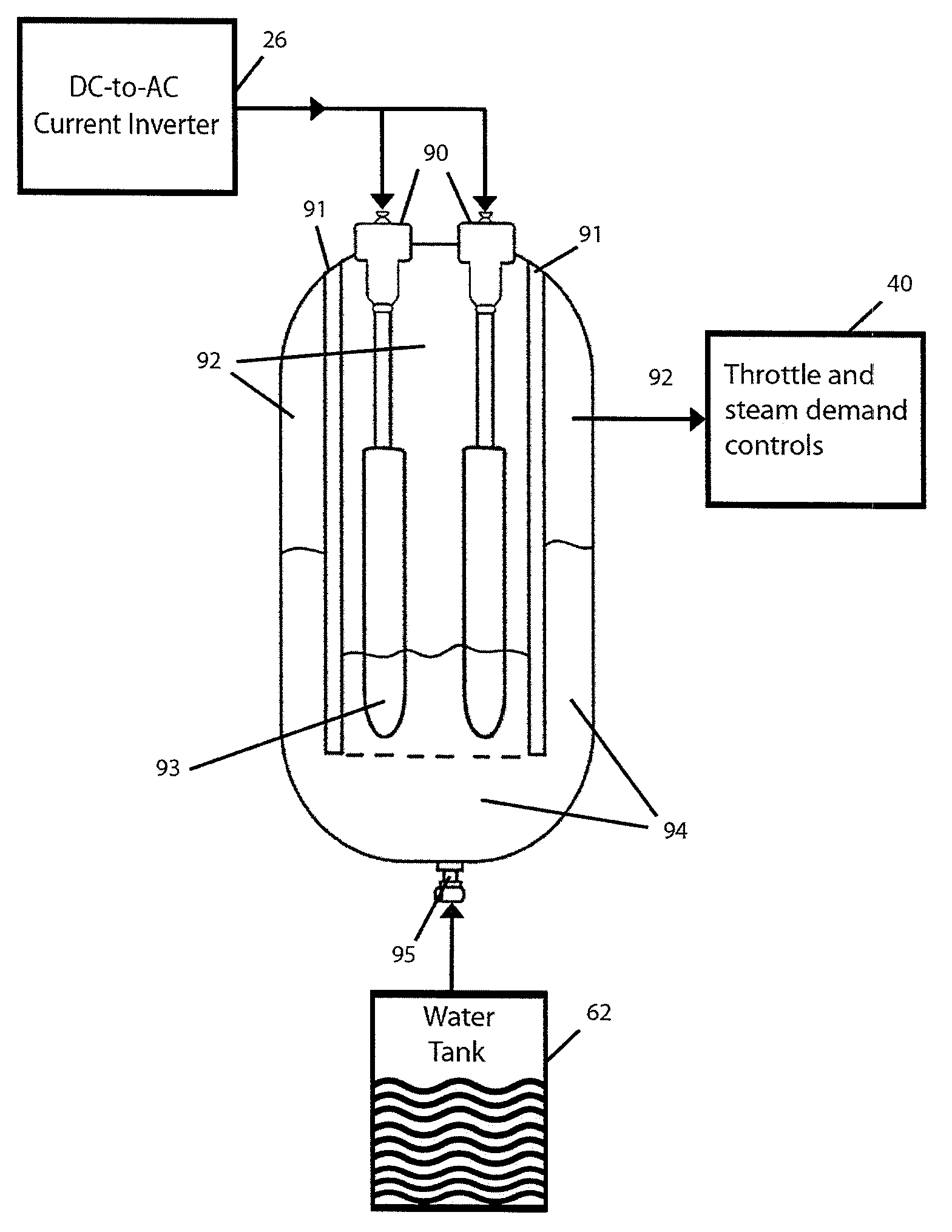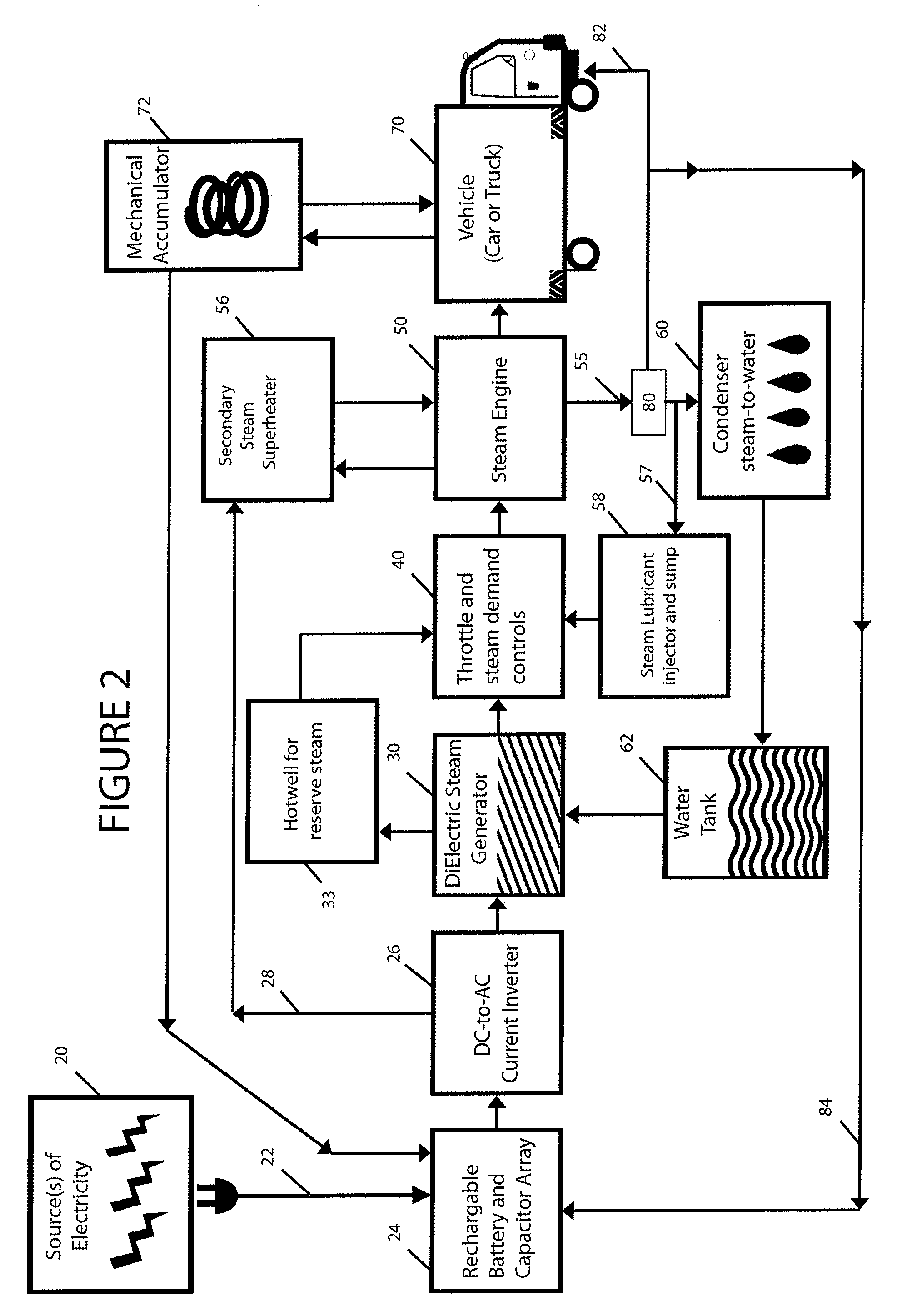[0029]Although the present invention has a great many potential uses, it is contemplated that the most significant
advantage of the present invention lies in the
elimination of the need for
gasoline, or any other
liquid fuel, from vehicle engines. The value of reducing or eliminating the dependence upon fossil fuels for power and transportation is impossible to overstate under existing geopolitical, economic and environmental conditions.
[0030]The unique combination of elements in the present invention produces a
dielectric-steam
hybrid engine system without any internal
combustion and eliminates the need for fossil fuels to drive automobiles or other vehicular systems that use internal
combustion engines. Therefore, it also eliminates the deadly
threat of
carbon monoxide poisoning associated with all
fossil fuel internal
combustion engines.
[0031]The ESG or other steam generator for the invention can be powered by any source of electrical energy, such as a combination of on-board batteries,
shore power charging (for example, overnight charging, as utilized in the “Prius Plus” available through www.CalCars.org), and newly developed power generation technologies (for example: solar cells on the car or
truck roof). Vehicles using the inventive system may also be equipped with accumulator devices to recover additional
mechanical energy and regeneratively feed it back to the batteries, a scheme which is readily available to those who are skilled in the art of
automotive engineering, and presently such devices can be installed in existing gasoline-electric
hybrid vehicle designs. Due to the high price and limited supply of gasoline and fossil fuels, there is presently a great incentive for the development of such new power generation technologies, and the present system is versatile enough to accommodate the use of many such technologies, as long as they are capable of running a
dielectric heating device such as the dielectrical steam generator, as described herein.
[0032]This invention allows a relatively lightweight and
small engine system to replace the comparatively large and heavy engine, transmission and exhaust systems associated with internal combustion. It also provides tremendous amounts of torque in a small
package. Those factors serve to overturn the current design paradigm that has been trending toward smaller and smaller vehicles in order to take
advantage of “alternative fuel” sources. Even as the world's cars have been getting smaller and smaller, it is clear that when given the chance the public has consistently shown a strong preference for larger vehicles—large cars, SUVs, and
pickup trucks. This public preference has drawn a lot of criticism from parts of the environmental movement in recent decades but studies have shown that larger cars are
safer cars and that when vehicles get smaller a disproportionate amount of injuries and deaths occur. The smaller the car, the more likely the occupants are to be maimed or killed when a collision occurs. The inventive dielectric-steam hybrid engine system makes it possible to once again build large cars, SUVs, and trucks with real desirable road power characteristics without having to worry about damaging the immediate environment. The invention will facilitate a return to full-size vehicles in terms of both driver and passenger space and
trunk and cargo capacity.
[0033]The present invention thus provides technology which is extremely versatile and can be scaled from small engines, such as those which might be used to power a push-type
lawn mower or
snow blower, to automotive vehicles, right up to trucks,
tractor trailers, construction vehicles,
lawn tractors, buses, motorcycles and scooters, farm machinery, forklifts, industrial and mining equipment, military vehicles, and even to
train locomotives,
light rail trolleys, boats and beyond by simply increasing the number and / or size of the
steam engine cylinders and / or the number and / or size of the electric steam generator, and / or increasing the capacity of electrical input—for example, by increasing the number or size of batteries, capacitors,
fuel cells, or other sources of electrical input. The electrical input can include newly developed technologies such as
solar power in some embodiments, especially for those vehicles which have large surface areas that would lend themselves to being covered with solar cells such as large trucks, trains, ships, and some types of manned or unmanned aircraft, such as drones or dirigibles.
[0034]In addition to eliminating the need to use internal combustion engines in vehicles, this invention also allows for the
elimination from vehicles of some or all of a host of gasoline-associated systems such as the ignition,
timing system,
carburetor, cooling system,
clutch, transmission,
muffler and
catalytic converter. Thus, the need for manufacture of and repairs to these costly and complicated systems will be greatly reduced or eliminated.
 Login to View More
Login to View More  Login to View More
Login to View More 









